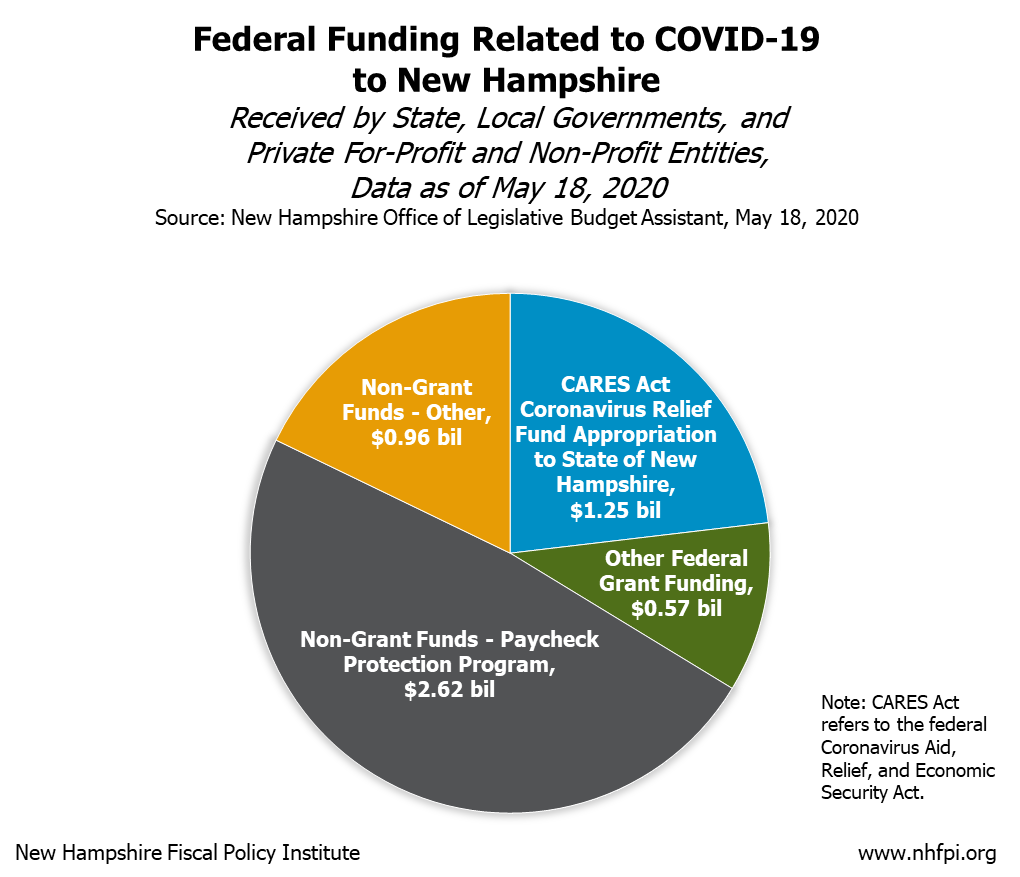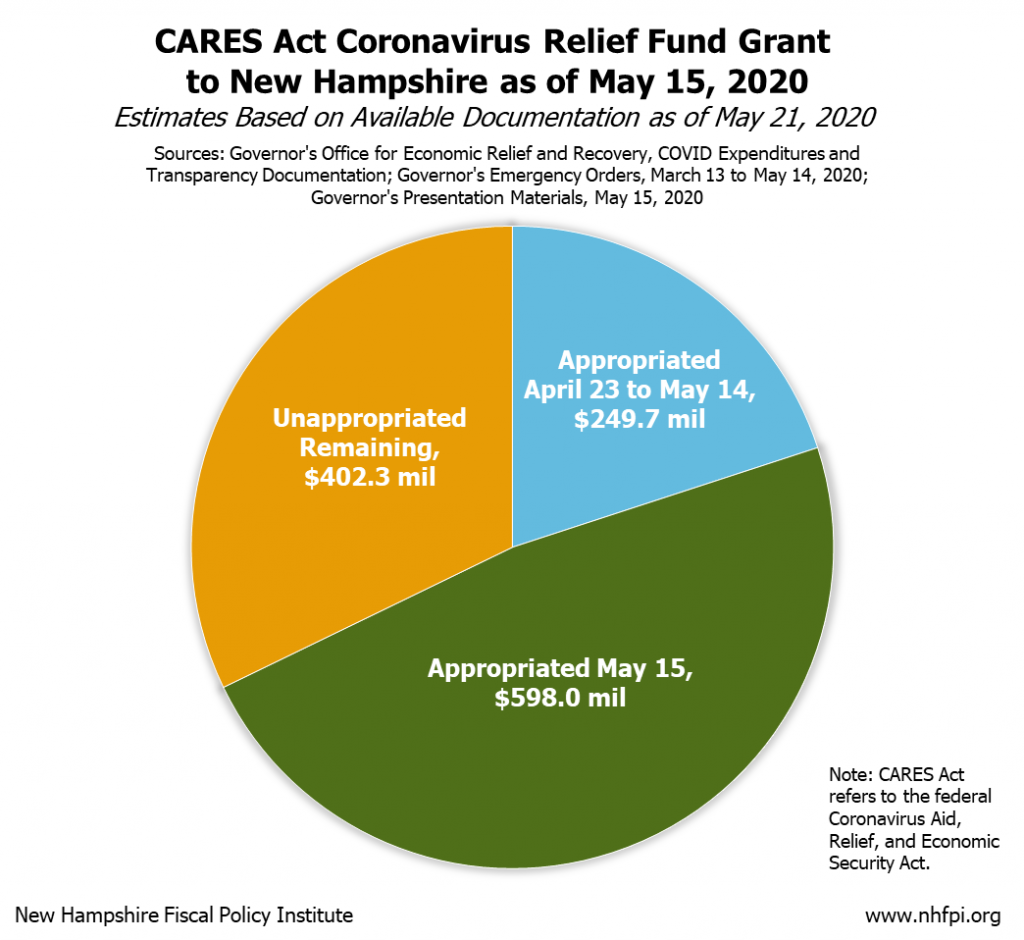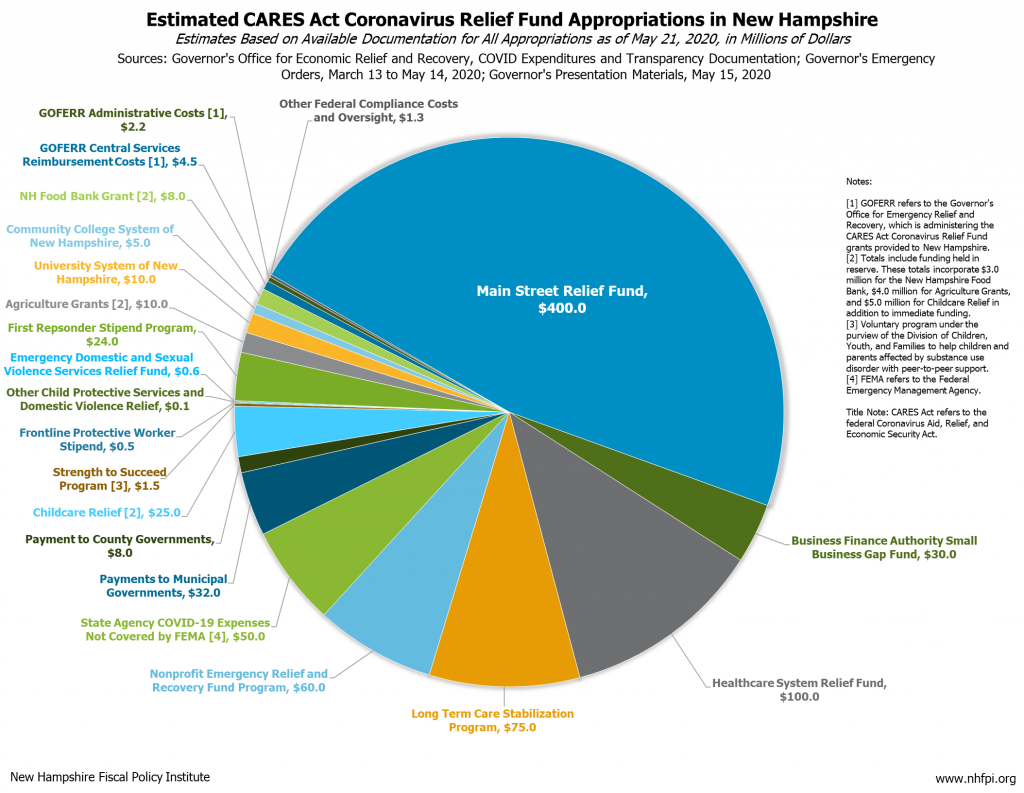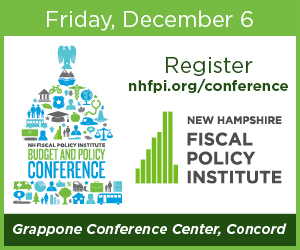The State of New Hampshire has appropriated most of the flexible funding provided by the federal government in response to the COVID-19 crisis. Following the Governor’s announcements on May 15, 2020, all but approximately $402 million of the $1.25 billion provided to New Hampshire as part of the Coronavirus Aid, Relief, and Economic Security (CARES) Act had been dedicated to specific purposes by the State. The federal government sought to provide states with some resources and discretion to respond to the health impacts and economic ramifications of the pandemic. These flexible funds were deployed in concert with other directed CARES Act supports, including other aid for businesses and assistance to individuals, and followed aid from other federal legislation.
Building on previous appropriations, the Governor’s office dedicated the large majority of the May 15 appropriations to a new program designed to support smaller businesses in the state, with additional support going to health care entities, child care, higher education, and nonprofit organizations that do not fall into any of the other categories of entities receiving aid.
CARES Act Funding and State Flexibility
Funding appropriated to the State of New Hampshire through the federal CARES Act to assist Granite Staters and provide relief during the COVID-19 crisis came in several different forms. Three recent COVID-19 crisis-related federal laws enacted, including the CARES Act, have provided money to New Hampshire. Of federal assistance to New Hampshire organizations tracked by the New Hampshire Office of Legislative Budget Assistant, nearly half (48.5 percent) came through the Paycheck Protection Program (PPP). The PPP was designed to provide direct incentives for small businesses, including nonprofits, sole proprietors, independent contractors, self-employed people, and businesses with less than 500 employees, to keep workers on their payrolls. With more than $2.6 billion distributed to New Hampshire organizations, the PPP is the single largest type of federal assistance to New Hampshire organizations from the three initial pieces of federal legislation.
The next largest piece was the $1.25 billion appropriated to the State of New Hampshire through the CARES Act from the federal Coronavirus Relief Fund (CRF). The State of New Hampshire has considerable flexibility for the use of these funds, although they must be for costs incurred on or before December 30, 2020 and cannot be used to offset revenue losses or to pay for previously-budgeted items. The remainder of tracked federal assistance has come through direct grants to the state government for specific purposes, as well as to municipalities, educational institutions, health care providers, airports, and other organizations.
Earlier CARES Act Appropriations
The $1.25 billion in CRF grant funding appropriated to New Hampshire from the CARES Act is currently being allocated at the discretion of the Governor, under the existing State of Emergency, and being administered by the Governor’s Office for Emergency Relief and Recovery (GOFERR). From the receipt of the CRF grant on April 23 to May 14, the Governor had appropriated approximately $250 million, based on available documentation. These earlier decisions included financial support for health care providers, funds to support long-term care workers and organizations, additional pay for first responders, payments to municipal and county governments for COVID-19-related expenses, funding to child protection and domestic violence prevention efforts, covering added State agency costs, and GOFERR oversight and administrative costs.
The Governor, after reviewing the specific appropriation recommendations from the GOFERR’s Legislative Advisory Board, announced an additional $598 million in appropriations on May 15. These appropriations and the approximately $250 million allocated earlier leave about $402 million, or about one third of the original total, in reserve for expenditures later in the year.
New Appropriations and Overall Allocations
The appropriations announced May 15 include significant new programs, with the large majority of the $598 million added dollars going to support for-profit businesses through a new relief fund. Although many of the details have yet to be determined or announced, these actions will devote resources to key areas through both new and existing initiatives:
- The Main Street Relief Fund, which was appropriated $400 million of the $598 million newly announced, is to provide emergency relief for businesses with less than $20 million in revenue during tax year 2019. Businesses must submit prequalification materials by May 29, including information about their COVID-19-related costs and receipt of PPP or other federal relief. Health care, child care, and agricultural businesses are addressed through other programs and are ineligible. The New Hampshire Department of Revenue Administration will collect the information, and State officials will then determine the final award criteria for the program, based on the applications received, by June 1. Formal applications will subsequently be due June 8.
- The Nonprofit Emergency Relief and Recovery Fund, which is expected to be open for applications June 5 with additional guidance published, received a $60 million appropriation for three purposes. The Fund will support nonprofit organizations that are reducing the public health and economic impacts of the crisis; contributing to economic, cultural, or civic vitality through arts, community or economic development, outdoor recreation, or other means; or supporting coalitions, networks, or collaboratives of nonprofits to maximize cooperation and impact.
- The Healthcare System Relief Fund, a program the Governor had previously created to provide emergency relief through loans or grants to hospitals and other health care providers, was boosted with a $50 million additional appropriation, with $30 million dedicated to supporting long-term care providers.
- The Small Business Gap Fund will be administered by the Business Finance Authority. An appropriation of $30 million will support this program, with more details forthcoming.
- New Hampshire Childcare Relief funding of $20 million, with an additional $5 million held in reserve for future needs, will be used for work facilitated by the New Hampshire Departments of Education and Health and Human Services to target health, safety, workforce, and operational supports to child care, and coordinate business needs with family needs, including day camp and other options for the summer and fall.
- New Hampshire Agriculture Grants will be provided to dairy, fruit, vegetable, and ornamental plant growers in the state, drawing from a $10 million appropriation. The New Hampshire Department of Agriculture, Markets, and Food will allocate $4.5 million to dairy farmers and $1.5 million to other farmers, with $4 million left in reserve for emergency grants.
- The New Hampshire Food Bank Grant specifically allocates $5 million, with another $3 million held in reserve to be deployed as needed, to the New Hampshire Food Bank to combat the rise of food insecurity in New Hampshire with the COVID-19 crisis.
- New Hampshire Higher Education System Grants will provide $15 million to New Hampshire’s public colleges and universities. The University System of New Hampshire will receive $10 million to strengthen online learning and degree programs and perform public health testing and surveillance for students and staff. The Community College System of New Hampshire will also receive funds for testing, as well as for distance learning adaptations for lab and other courses that must be delivered in person to be effective.
These new appropriations and initiatives add to a wide array of previously-appropriated funds, totaling approximately $848 million of the $1.25 billion in CRF grant dollars available. These appropriation figures do not account for smaller commitments that do not yet have specific dollar figures attached; the GOFERR reports tracked expenditures as part of its oversight of COVID-19-related funds. Overall, this aid includes significant support for smaller businesses, health and long-term care providers, local governments and first responders, child care and child protection, food aid, higher education, and nonprofits.
Despite these appropriations, there are ongoing and expanding needs in this crisis, including in areas that have not yet been addressed by CRF grant appropriations. The Governor identified housing, homelessness, and primary, secondary, and private higher education as areas for potential future use for remaining portion of the CRF grant. Housing will be an even more critical area of need, especially for people with limited incomes and fewer resources, when the State of Emergency is lifted and the moratorium on evictions and foreclosures expires. While the appropriations to health care organizations are significant, the amount allocated to health care providers in the Healthcare System Relief Fund is lower than the recommended amount from the GOFERR’s Legislative Advisory Board. Additionally, the appropriations do not include any direct aid to individuals, which is helpful for both providing immediate relief to people and effectively supporting economic growth.
With approximately one-third of the CARES Act Coronavirus Relief Fund grant to New Hampshire remaining, building on the existing appropriations in a manner cognizant of the challenges facing the most vulnerable Granite Staters will be critical to helping individuals and families through this crisis and create an equitable and sustainable recovery for everyone in New Hampshire.
– Phil Sletten, Senior Policy Analyst




